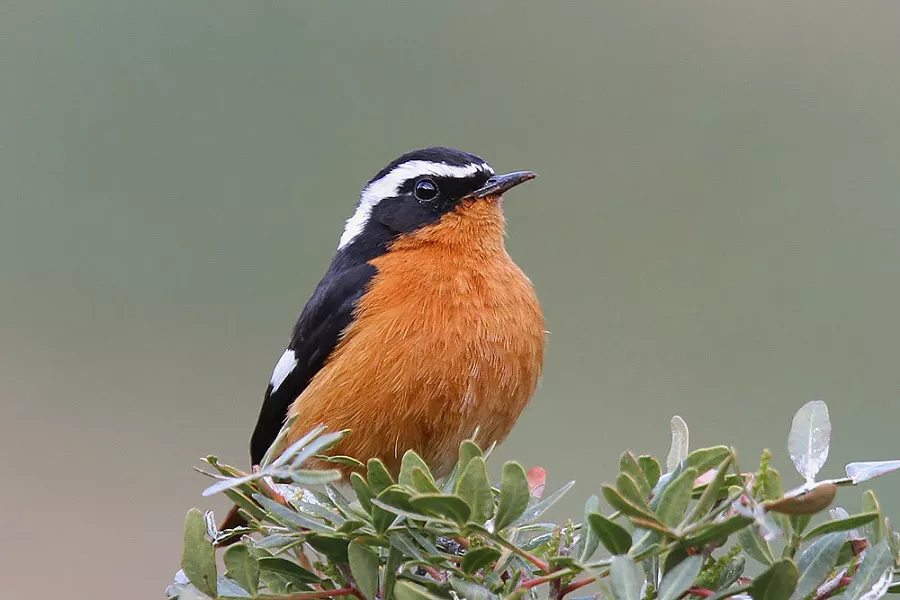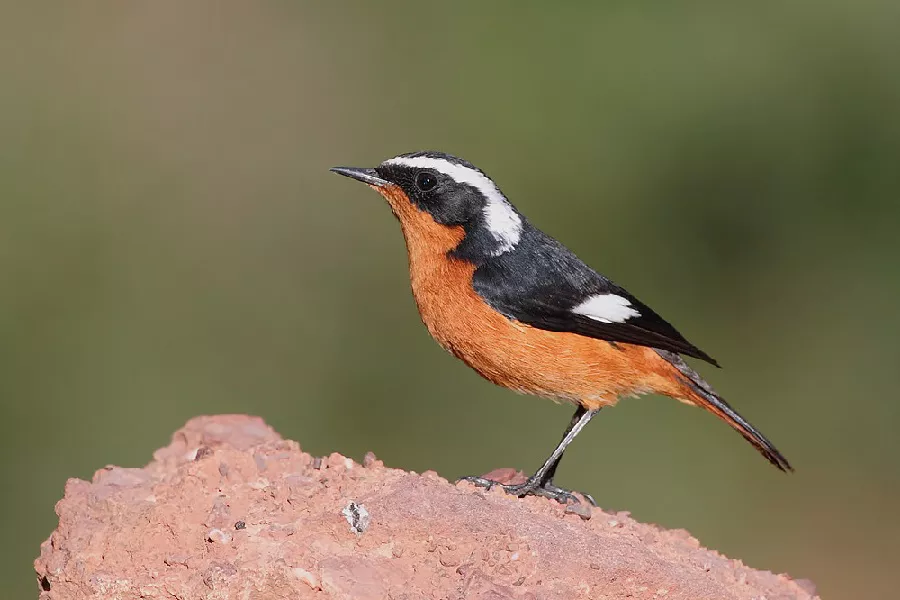Morocco, a country known for its diverse landscapes and rich cultural heritage, boasts a variety of unique and fascinating wildlife. Among these, the national bird, the Moussier’s Redstart (Phoenicurus moussieri), stands out as a symbol of the country’s natural beauty. This bird, with its striking plumage and distinctive behaviors, is not only a visual delight but also an important part of Morocco’s ecosystem. This article delves into the Moussier’s Redstart, exploring its habitat, physical characteristics, behavior, diet, breeding habits, and conservation status.
Habitat and Distribution
Geographic Range
The Moussier’s Redstart is endemic to North Africa, with its range predominantly encompassing Morocco, Algeria, and Tunisia. In Morocco, it can be found across various regions, from the coastal areas to the Atlas Mountains and the arid landscapes of the Sahara Desert.
Preferred Habitats
This bird is highly adaptable and occupies a variety of habitats. It is commonly found in open woodlands, scrublands, and rocky terrains. It also inhabits agricultural areas and gardens, often seen perched on fences or low bushes. The diversity in its habitat preference is a testament to its adaptability and resilience.
Elevation Range
The Moussier’s Redstart can be found at various elevations, from sea level up to high altitudes in the mountains. In the Atlas Mountains, it is observed at elevations up to 3,000 meters. This wide elevation range further highlights its adaptability to different environmental conditions.
Physical Characteristics
Size and Weight
The Moussier’s Redstart is a small bird, measuring about 12-13 centimeters in length and weighing between 12 to 15 grams. Despite its small size, it is a robust bird, well-adapted to its environment.

Moussier’s Redstart
Plumage
The plumage of the Moussier’s Redstart is striking and distinctive. Males are particularly colorful, with bright orange underparts, a black head, and white patches on the wings and forehead. The back and tail are a rich, rusty-red color. Females, while less colorful, are still attractive, with more subdued brown and orange tones that provide excellent camouflage against the natural backdrop.
Sexual Dimorphism
There is a noticeable difference between the males and females, a phenomenon known as sexual dimorphism. Males are more vividly colored, which plays a role in attracting mates, while females have more cryptic coloration, aiding in nest protection and predator avoidance.
Behavior
Feeding Habits
The Moussier’s Redstart is an insectivorous bird, feeding primarily on insects and other small invertebrates. It forages actively, often seen darting from perches to catch prey mid-air or picking insects from the ground and foliage. Its diet includes beetles, ants, spiders, and caterpillars.
Territoriality
This species is highly territorial, especially during the breeding season. Males are known to aggressively defend their territories from intruders, using vocalizations and physical displays to ward off competitors. The establishment and maintenance of territories are crucial for attracting mates and ensuring breeding success.
Vocalizations
The Moussier’s Redstart has a variety of vocalizations used for communication. Its song is a series of melodious and rapid notes, often delivered from a prominent perch. These songs play a significant role in territorial defense and mate attraction. Additionally, it has various calls used to communicate with mates and offspring or to signal alarm in the presence of predators.
Breeding and Reproduction
Breeding Season
The breeding season of the Moussier’s Redstart typically occurs from March to June. During this time, males become highly vocal and display their colorful plumage to attract females. The timing of the breeding season is closely linked to the availability of food resources, ensuring that the chicks have ample nourishment during their growth period.
Nesting
The nests of the Moussier’s Redstart are usually built in sheltered locations, such as rock crevices, tree hollows, or dense shrubs. The nests are constructed primarily by the female, using materials like grass, moss, and feathers to create a well-insulated and camouflaged structure. The choice of nesting site is crucial for protection against predators and harsh weather conditions.
Clutch Size and Incubation
A typical clutch consists of 3-6 eggs, which are pale blue or greenish in color, often speckled with brown or gray. The female is primarily responsible for incubation, which lasts about 12-14 days. During this period, the male plays a supportive role, bringing food to the female and guarding the nest site.
Chick Development
After hatching, the chicks are altricial, meaning they are born blind, naked, and entirely dependent on their parents. Both parents share the responsibility of feeding and caring for the chicks. The diet at this stage consists mainly of soft-bodied insects, which are easier for the chicks to digest. The fledging period lasts approximately 12-15 days, after which the young birds leave the nest but continue to receive parental care for a few more weeks until they are fully independent.
Conservation Status
Current Status
The Moussier’s Redstart is currently classified as Least Concern by the International Union for Conservation of Nature (IUCN). This status indicates that the species is not at immediate risk of extinction and has a relatively stable population. However, ongoing monitoring is essential to ensure that this status remains unchanged.
Threats
Despite its current status, the Moussier’s Redstart faces several threats that could impact its population in the future. Habitat loss due to agricultural expansion, urbanization, and deforestation is a significant concern. Additionally, climate change poses a threat by altering the availability of food resources and suitable habitats.
Conservation Efforts
Several conservation efforts are in place to protect the Moussier’s Redstart and its habitat. Protected areas and national parks in Morocco play a crucial role in preserving the natural habitats of this species. Furthermore, awareness campaigns and community involvement in conservation activities help promote the protection of this iconic bird.
Research and Monitoring
Continued research and monitoring are vital for understanding the population dynamics and ecological requirements of the Moussier’s Redstart. Long-term studies on breeding success, migration patterns, and habitat use provide valuable data that inform conservation strategies. Collaboration between local and international conservation organizations enhances the effectiveness of these efforts.
Ecological Role
Pest Control
As an insectivorous bird, the Moussier’s Redstart plays a significant role in controlling insect populations. By feeding on various insects, it helps maintain a balance in the ecosystem, preventing the overpopulation of certain insect species that could otherwise become pests.
Seed Dispersal
Although primarily insectivorous, the Moussier’s Redstart occasionally consumes fruits and berries. This behavior contributes to seed dispersal, aiding in the regeneration of plants and the maintenance of plant diversity in its habitat.
Indicator Species
The presence of the Moussier’s Redstart in an area can serve as an indicator of environmental health. Because it relies on a diverse and healthy insect population for food, its presence suggests that the ecosystem is functioning well. Monitoring its population trends can provide insights into broader ecological changes and potential environmental issues.
Cultural Significance
National Symbol
The Moussier’s Redstart holds a special place in Moroccan culture as the national bird. Its vibrant colors and lively behavior are a source of pride and symbolize the natural beauty and diversity of the country. The bird is often featured in local art, folklore, and literature, reflecting its importance in Moroccan heritage.
Ecotourism
Birdwatching and ecotourism are growing industries in Morocco, and the Moussier’s Redstart is a popular species among birdwatchers. Its striking appearance and relatively wide distribution make it a sought-after sighting for tourists and nature enthusiasts. Promoting ecotourism can help raise awareness about the importance of conservation and provide economic benefits to local communities.
Educational Value
The Moussier’s Redstart is also valuable for educational purposes. Studying this bird can teach us about avian biology, ecology, and the importance of biodiversity. Educational programs and initiatives that highlight the Moussier’s Redstart can foster a greater appreciation for wildlife and the need for conservation efforts.
Conclusion
The Moussier’s Redstart, Morocco’s national bird, is a remarkable species that embodies the country’s rich natural heritage. Its striking appearance, diverse habitat preferences, and important ecological roles make it a key component of Morocco’s biodiversity. While currently not at risk of extinction, continued conservation efforts are essential to ensure its long-term survival. By protecting the Moussier’s Redstart and its habitat, we preserve not only a beautiful bird but also the ecological balance and natural beauty of Morocco. Through research, conservation, and education, we can ensure that future generations will continue to enjoy and appreciate this iconic species.
FAQs
What is the national animal of Morocco?
The national animal of Morocco is the Barbary lion (Panthera leo leo). Once native to North Africa, the Barbary lion is now extinct in the wild. It symbolizes strength and resilience, reflecting Morocco’s rich cultural heritage.
What is the national flower of Morocco?
The national flower of Morocco is the Rose. Particularly, the Damask Rose (Rosa damascena) is celebrated for its beauty and fragrance. The region of El Kelaa M’Gouna is famous for its rose festival, highlighting the importance of this flower in Moroccan culture.
What is the national tree of Morocco?
The national tree of Morocco is the Argan tree (Argania spinosa). This unique tree is indigenous to the southwestern region of the country and is known for its oil, which is highly valued for culinary, cosmetic, and medicinal purposes. The Argan tree also plays a crucial role in preventing desertification.


 Facebook
Facebook  Instagram
Instagram  Youtube
Youtube 